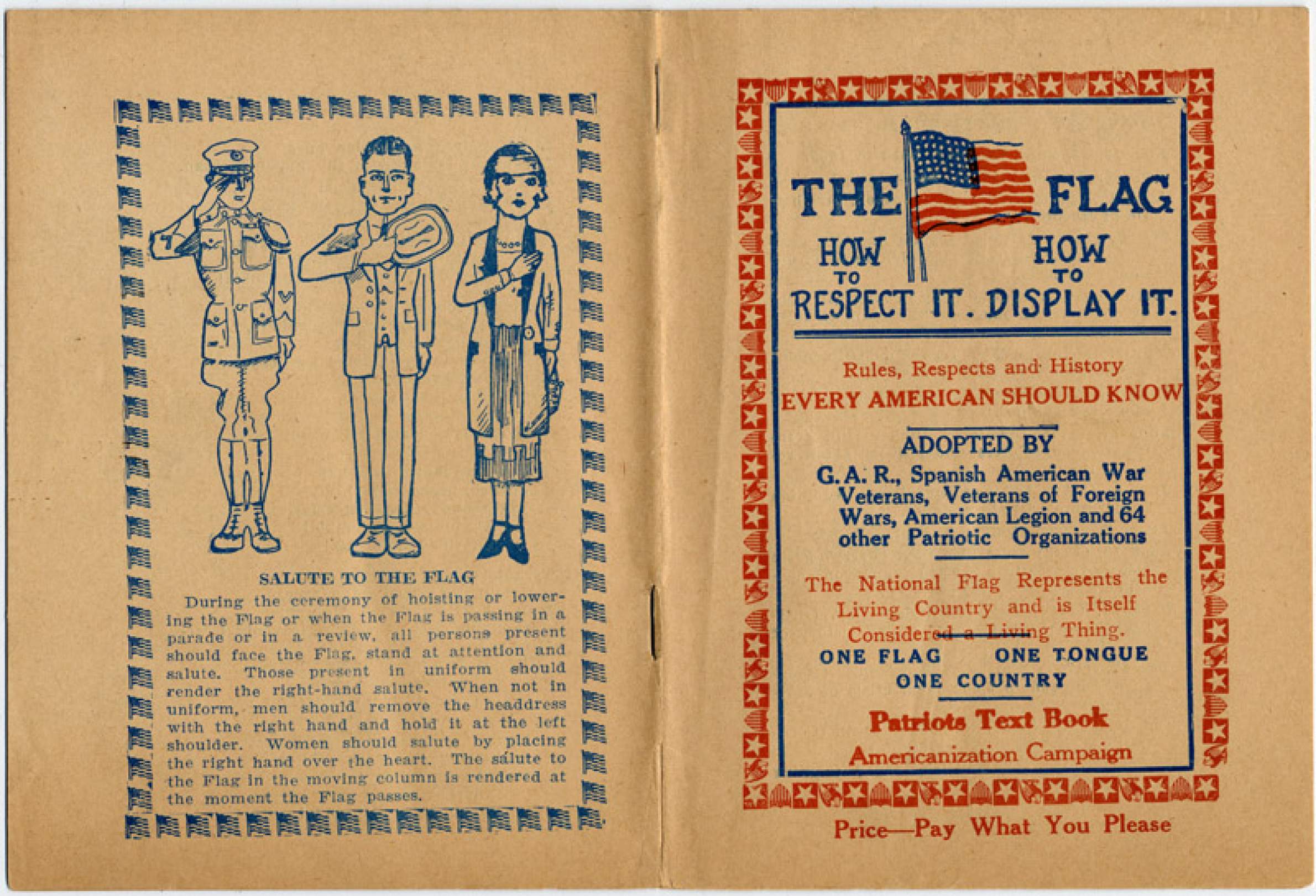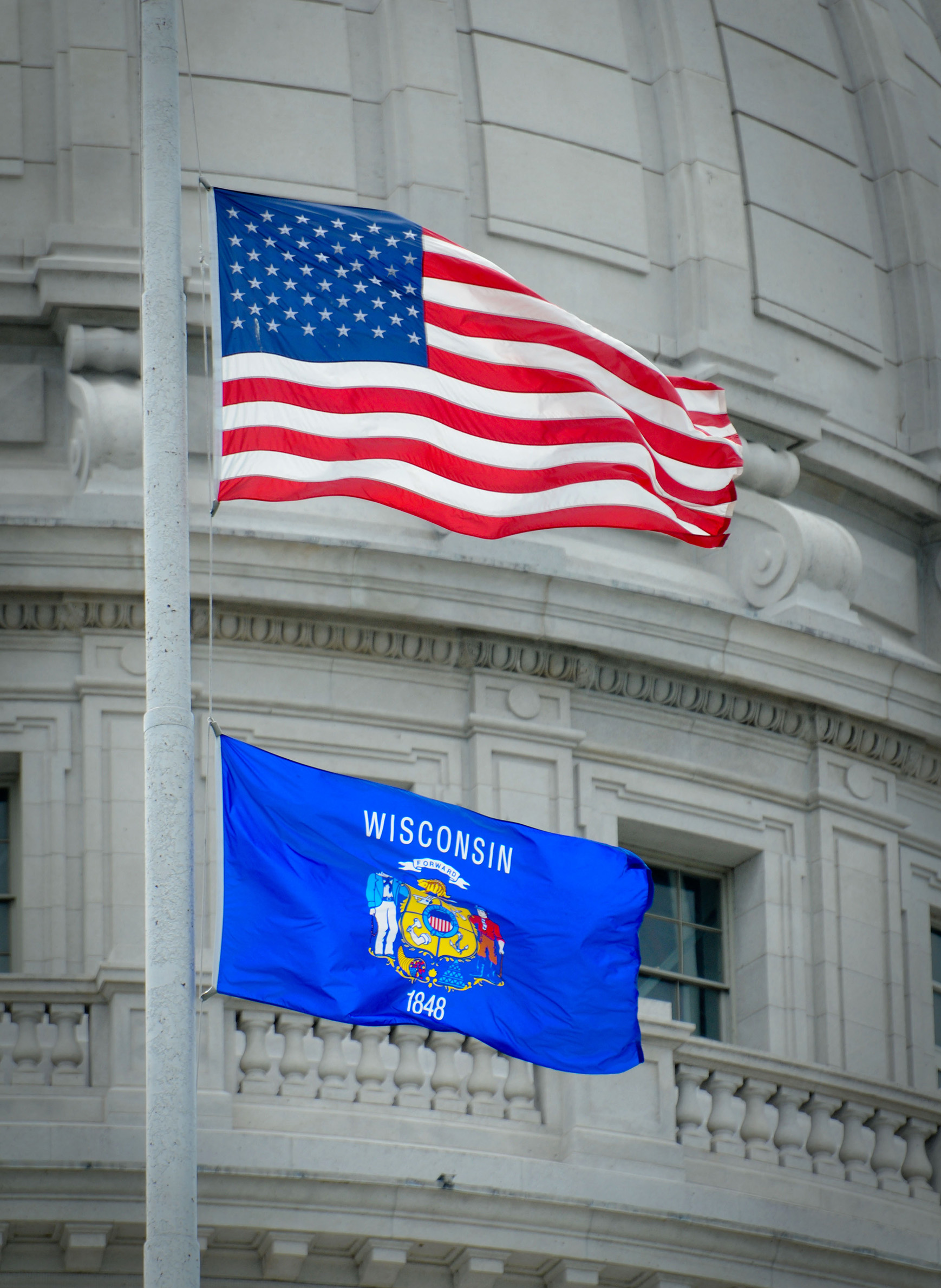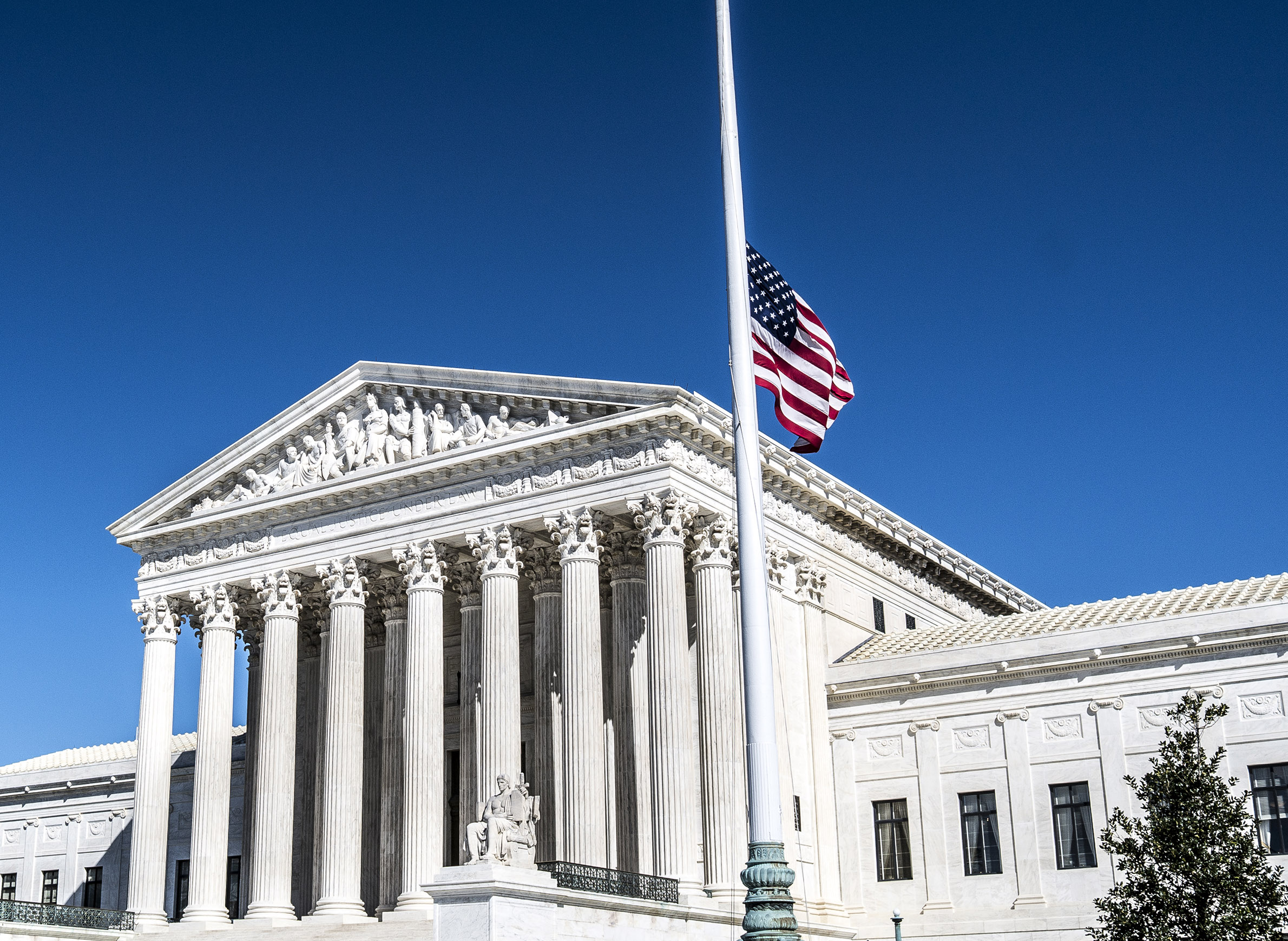Flying the United States flag at half-staff is a custom of honoring select dead that has taken shape over the course of the nation’s history. While it’s a time-honored practice, the reasons for taking the action and protocol governing it have changed considerably, and continue to do so.
In the 21st century, it may seem to observers that flags are being flown at half-staff more often. In 2015, flags were lowered somewhere across the U.S. nearly every day of the year. The Sept. 11, 2001 attacks marked a turning point in the practice, as have previous conflicts going back to the Civil War. Another factor driving changes is the growing prominence and frequency of mass shootings around the nation. Indeed, while such shootings have touched off an impassioned discussion about gun laws, they’ve also provoked calls to keep flags lowered in anticipation of the next atrocity. The question of what flying flags at half-staff means in an age when they’ve become a familiar sight is increasingly common.
Stay informed on the latest news
Sign up for WPR’s email newsletter.
How often do flags fly at half-staff in Wisconsin?
More than they used to.
By either presidential proclamation or a governor’s executive order, the U.S. and state flags in Wisconsin have been officially lowered to half-staff more than 400 times since 9/11, according to a WisContext analysis of available records. Flags are ordered to half-staff for a variety of reasons, but are typically related to deaths of military service persons, public safety officers, prominent public officials and others, and, more prominently, people who are killed in events like mass shootings. Flags are also routinely flown at half-staff for annual observances like Memorial Day, or since 2001, the anniversary of the Sept. 11 attacks, also called Patriot Day.
Between 2001 and 2018, flags have been ordered to be flown at half-staff in Wisconsin anywhere between 8 and 33 times per year. There was a spike in orders for four consecutive years from 2004 through 2007 during which the number exceeded 30 in each, owing to orders honoring members of the military killed in Iraq and Afghanistan. There was also a one-year spike above the 30 proclamation mark in 2016, a result of multiple mass casualty events and deaths of high-profile people. So far, 2018 is on track to exceed any of the previous 17 years, with 20 instances in the state as of the end of June.

Presiding in an era of high-profile terrorist acts abroad and mass shootings at home, President Barack Obama ordered flags to half-staff more than any other president before him. Those occasions included a 2012 attack on a Sikh temple in suburban Milwaukee that killed seven people and injured three others, as well as shooting in other states, such as the massacre of 27 students and teachers at Sandy Hook Elementary School in Newtown, Conn., in 2012, and the killing of 49 people at Pulse nightclub in Orlando in 2016.
“In times of crisis and times of cultural dislocation, in an effort to reinforce the sense of shared community … people turn to patriotic symbols,” said Scot Guenter, a professor of American studies at San Jose State University and founding editor of “Raven: A Journal of Vexillology.” “And the flag since the Civil War has been that symbol.”
The U.S. Flag Code includes guidance on when and how the nation’s flag should be lowered to half-staff — until noon on Memorial Day or to mourn the passing of sitting presidents, senators, Supreme Court justices or state governors. But presidents and governors also have the authority to issue flag-lowering orders when they see fit, and they aren’t always universally embraced by the public.
With flags flying at half-staff more often, flag expert James Ferrigan wonders if it’s losing some of its meaning.
“People don’t know what it’s for,” said Ferrigan, who curates the Zaricor Flag Collection, which gathers and preserves rare U.S. flags. “It’s not an honor — you’re in mourning. What becomes common becomes less special. It used to be rare that you’d see flags at half-staff. Politics has kind of muddied it up, in my opinion.”
In the years since 9/11, practice at the state level has preceded changes to the national flag code.
For example, the code was amended on June 29, 2007 to include fallen military service members. By then, governors in Wisconsin had long been ordering flags to half-staff when a service member was killed.
Since 2001, Wisconsin governors have also lowered the state and national flags for dozens of local police, firefighters or other emergency workers who were killed in the line of duty. But it was not until earlier February 2018 when Congress tacked the federal budget (the Bipartisan Budget Act of 2018) onto an obscure bill called the Honoring Hometown Heroes Act was that practice enshrined in the U.S. Flag Code.
“The law is just catching up with public sentiment,” said Guenter, who as a vexillologist studies flags. “The flag code is just etiquette. When they created the flag code, the idea was that the flag represents a living, vibrant culture. You have to treat it like it’s alive, with respect, as you treat human beings.”
The origins and history of flying flags at half-staff
The half-staff flag tradition dates back at least as far as the 17th century. The first documented instance was in 1612, when the crew of the British ship “Heart’s Ease” lowered its flag to half-mast after the captain, James Hall, was killed during an expedition to Greenland. It is believed that the gesture was meant to accommodate the invisible “flag of death” flying above the Union Jack.
“It came from traditions of ships at sea. The practice spread from doing it at sea to doing it at forts,” said Scot Guenter. “The powerful semiotic meaning and use of the flag, that comes later. In the 18th century, [the flag] was more of an identification marker, or who this fort belongs to.”
Among the early references to flag lowering as a sign of mourning in the U.S. was upon the death of President George Washington in December 1799. The Navy Department issued issued an order that ships would express national mourning “by wearing their Colours half-mast high.”
The U.S. Flag Code grew from the concerns of Civil War veterans in the late 19th century that the national symbol was being misappropriated for commercial and advertising purposes. In 1923, in the wake of the First World War, the National Americanism Commission convened the first National Flag Conference to establish a set of rules for the civilian use of flags. The conference was organized by The American Legion and attended by representatives from many other groups, including the U.S. Army and U.S. Navy, the Daughters of the American Revolution, the American Federation of Labor and the Ku Klux Klan.
Congress adopted the U.S. Flag Code in 1942, which included parts of the Americanism Commission’s rules. President Franklin D. Roosevelt signed it on June 22, 1942. Over the years, the Flag Code has been amended and in 1998 was re-codified as part of title 4.
But the rules for lowering flags to half-staff were loose until 1954, when President Dwight Eisenhower signed a presidential proclamation that standardized the dates and time periods for flying the U.S. flag at half-staff from federal buildings, grounds and naval vessels.
Specifically, it established that U.S. flags fly at half-staff for 30 days after the death of a president or former president, and 10 days after the death of a vice president, Supreme Court chief justice or retired chief justice, or speaker of the House of Representatives. For a Supreme Court associate justice, Cabinet member, former vice president, president pro tempore of the Senate, or the House and Senate majority or minority leader, flags are to fly at half-staff from death until their burial. The same rules apply to federal properties in a state or territory if a governor dies in office. Flags are to fly at half-staff on the day after the death of a senator, member of Congress, territorial delegates or the resident commissioner of the Commonwealth of Puerto Rico.
Eisenhower’s proclamation also provided that the president could order flags to half-staff in the event of the death of other officials, former officials or foreign dignitaries, or “in accordance with recognized customs or practices not inconsistent with law.”
In addition to Memorial Day, when flags fly at half-staff until noon, Congress has added additional annual observances over the years:
- Sept. 11: In December 2001, Congress designated Sept. 11 as Patriot Day and ordered that flags fly at half-staff.
- May 15: Peace Officers’ Memorial Day. In 1994, Congress amended a 1962 law establishing Peace Officers’ Memorial Day and, ordering that flags fly at half-staff, unless the date fell on Armed Forces Day, the third Saturday in May, in which case flags should fly at full staff.
- First Sunday in October: In 2001, Congress passed a resolution ordering flags to half-staff in honor of the National Fallen Firefighters Memorial Service, as part of National Fire Prevention Week. Under a state law passed in 2011, Wisconsin Firefighters Memorial Day is observed on the Saturday at the end of Fire Prevention Week.
- Dec. 7: In 1994, Congress established the annual National Pearl Harbor Remembrance Day, which calls for flags to fly at half-staff.
Flags fly at half-staff until noon only on Memorial Day, and at full staff on Veterans Day, which is meant to honor living veterans.
The trends of flying flags at half-staff in Wisconsin
No state agency in Wisconsin keeps comprehensive records about when and why flags fly at half-staff. Neither the state Department of Administration nor the Department of Military Affairs keep archival records about the practice. But a WisContext review of gubernatorial executive orders and presidential proclamations shows that flags flew at half-staff more often in most years after Sept. 11, 2001 than in the preceding decade.
WisContext sorted state and federal flag-lowering orders into a spreadsheet with five categories: disasters such as Hurricane Katrina; mass casualty events such as school shootings or terrorist attacks; military deaths and related annual observances such as Memorial Day; the deaths of public figures; and public safety, which includes the deaths of local police or firefighters and memorial observances for those killed in the line of duty.
In the years following 9/11, half-staff flags were a frequent reminder of the human cost of war.
Between the spring of 2003 and the fall of 2016, Gov. Jim Doyle and his successor, Gov. Scott Walker, ordered flags to half-staff 137 times to mourn those killed in Iraq and Afghanistan. The first instance was on April 2, 2003, for U.S. Marine Corps Maj. Kevin Nave, who died in Iraq shortly after the start of the war. The most recent was on Sept. 3, 2016, for U.S. Army Sgt. Matthew V. Thompson, who was killed by an improvised explosive device in Helmand Province, Afghanistan.
Flags were ordered to half-staff the most often between 2004 and 2007, during the years of heaviest fighting in Iraq. However, they continued at a steady pace over the next few years, and there was another spike in 2015 and 2016. Military deaths or annual military observances account for almost half of all times flags were lowered in Wisconsin since 2001.
Wisconsin military members were also victims of gunman attacks on military bases at home. In 2009, Staff Sgt. Amy Krueger and Capt. Russell Seager died when a sniper opened fire at Fort Hood Army Base in Texas. In 2015, Sgt. Carson Holmquist was one of four Marines killed in an attack on an operations center in Chattanooga, Tenn.
There is also a big gender gap in the practice: Flags fly at half-staff far less often for women than men. Of the 150 times they were lowered for military members who died on active duty, only eight were women, five of whom died in Iraq. Among 58 fallen public safety officers to be honored — which includes police, firefighters and other responders — four were women, about seven percent of the total. Meanwhile, flags flew at half-staff 59 times for the deaths of public figures, nine of whom were women.
The protocol of flying flags at half-staff
When the president issues a proclamation ordering flags to half-staff, the governor’s office notifies state agencies and tells them their flags should be lowered as well, said Amy Hasenberg, a Walker spokesperson. In some cases, such as the death of a prominent government figure, the governor’s office issues an executive order as well.
For example, Walker issued executive orders to lower the U.S. and Wisconsin flags upon the death of former First Ladies Nancy Reagan in 2016 and Barbara Bush in 2018. He also issued an executive order upon the February 2016 death of U.S. Supreme Court Justice Antonin Scalia, and in July of that year when police officers in Dallas and Baton Rouge were killed.
When flags are ordered to half-staff, it’s the job of the state Department of Military Affairs to push out the information to state agencies and the public. The department maintains an alert system via email and text. But unless media outlets also take note, the public doesn’t always know why flags are down or when to lower flags on their own property.
Veterans’ groups and flag vendors take a keen interest in getting the word out.
American Flags Express in Butler, a suburb of Milwaukee, was one of the few companies selling flags on the internet on September 11, 2001. Owner Tom D’Amico was swamped with orders — and questions about flying flags at half-staff.
“Those types of questions continued for years, actually,” he said.
In 2003, D’Amico started an email service for customers, alerting them when a federal proclamation was made to lower flags and letting them know when flags return to full staff. He eventually opened this service up to the public. Called Half Staff Alert, it now has over 100,000 subscribers and a staff of five people who track and verify both federal and state proclamations across the country.
“We want to be out fast with the information, but we want to be accurate,” D’Amico said. “It really does take a lot of time.”
Growing controversy over half-staff orders
Because the flag is such a powerful symbol, many people have strongly held opinions about when it should — or shouldn’t — be lowered to half-staff. Sometimes, they lean on the U.S. Flag Code in making their arguments.
In early July 2018, President Donald Trump drew criticism for how he treated a request to lower U.S. flags to half-staff for five journalists killed June 28 as they worked at the Capital Gazette in Annapolis, Md.
An Alabama county got national attention in 2016 when it refused to lower the flag after the shooting at a gay nightclub in Orlando. A member of the Baldwin County board cited the flag code, saying it didn’t list shootings or terrorist attacks as reasons to lower the flag.
When Obama ordered flags lowered after the death of former South African President Nelson Mandela in 2013, and Gov. Walker followed with a state order to do the same, U.S. Rep. Jim Sensenbrenner, R-Menomonee Falls, objected, saying that “lowering the flag should be for mourning Americans and not for foreign leaders.”
In 2004, local veterans took issue with Green Bay Packers President Bob Harlan when he lowered flags to half-staff at Lambeau Field after the death of Reggie White, the legendary defensive end.
Veterans’ groups occasionally chide local governments or citizens when they run afoul of the flag code. The American Legion advises that mayors or other local officials should not lower flags to half-staff without a presidential or governor’s order.
Violations of the flag code are not enforced, though. Even so, it’s not clear whether penalties would hold up under legal scrutiny. U.S. Supreme Court rulings striking down prohibitions on flag desecration in 1989 (Texas v. Johnson) and 1990 (United States v. Eichman) established that free speech extends to the use of flags.
“Flags are pretty much determined to be under the First Amendment,” said vexillologist James Ferrigan. “If you want to put your flag at half-staff, you’re free to do it.”
Graphics: Scott Gordon, WisContext
Why And When Wisconsin Flies Flags At Half-Staff was originally published on WisContext which produced the article in a partnership between Wisconsin Public Radio, Wisconsin Public Television and Cooperative Extension.
This report was produced in a partnership between Wisconsin Public Radio, PBS Wisconsin and the University of Wisconsin Cooperative Extension. @ Copyright 2025, Board of Regents of the University of Wisconsin System and Wisconsin Educational Communications Board.










